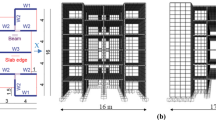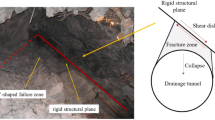Abstract
During deep rock mass excavation with the method of drill and blast, accompanying the secession of rock fragments and the formation of a new free surface, in situ stress on this boundary is suddenly released within several milliseconds, which is termed the transient release of in situ stress. In this process, enormous strain energy around the excavation face is instantly released in the form of kinetic energy and it inevitably induces microseismic events in surrounding rock masses. Thus, blasting excavation-induced microseismic vibrations in high-stress rock masses are attributed to the combined action of explosion and the transient release of in situ stress. The intensity of stress release-induced microseisms, which depends mainly on the magnitude of the in situ stress and the dimension of the excavation face, is comparable to that of explosion-induced vibrations. With the methods of time–energy density analysis, amplitude spectrum analysis, and finite impulse response (FIR) digital filter, microseismic vibrations induced by the transient release of in situ stress were identified and separated from recorded microseismic signals during a blast of deep rock masses in the Pubugou Hydropower Station. The results show that the low-frequency component in the microseismic records results mainly from the transient release of in situ stress, while the high-frequency component originates primarily from explosion. In addition, a numerical simulation was conducted to demonstrate the occurrence of microseismic events by the transient release of in situ stress, and the results seem to have confirmed fairly well the separated vibrations from microseismic records.













Similar content being viewed by others
Abbreviations
- a :
-
Scale parameter (wavelet transform)
- B :
-
Drilled burden
- b :
-
Time parameter (wavelet transform)
- C f :
-
Velocity of crack propagation
- C p :
-
P-wave velocity in the rock mass
- C u :
-
Velocity of rarefaction waves in detonation gases
- C ψ :
-
Admissibility condition
- D :
-
Velocity of detonation
- d :
-
Distance from the loading face
- d b :
-
Blasthole diameter
- d c :
-
Charge diameter
- E :
-
Elastic modulus
- e :
-
Elastic strain energy density
- E(b):
-
Time–energy density function
- E′(b):
-
Local time–energy density function
- f(t):
-
Function of vibration records
- F(ω):
-
Amplitude spectrum of the vibration record function
- k :
-
Parameter describing the propagating media
- L 1 :
-
Charge length
- L 2 :
-
Stemming length
- L 2(R):
-
Space of all finite energy functions
- P b(t):
-
Blasting load variation versus time
- P b0 :
-
Initial explosion pressure
- P be(t):
-
Equivalent blasting load on the excavation face
- P r(t):
-
Release process of the in situ stress
- r e :
-
Size of the loading face
- S :
-
Spacing between adjacent blastholes
- T :
-
Time
- t b :
-
Beginning time of the in situ stress release
- t d :
-
Duration of the blasting load
- t r :
-
Rising time of the blasting load
- U :
-
Elastic strain energy
- U 1 :
-
Elastic strain energy included in the excavation zone before excavation
- U 2 :
-
Elastic strain energy included in the stress-affected zone before excavation
- U 2′:
-
Elastic strain energy included in the stress-affected zone after excavation
- U exp :
-
Energy of explosion
- V b :
-
Initial blasthole volume
- v g :
-
Gas venting velocity
- V g(t):
-
Gas volume at any time
- V r :
-
Volume of rock
- v r :
-
Peak particle velocity at an observation point
- v r0 :
-
Peak particle velocity on the excavation face
- W f (a, b):
-
Continuous wavelet transform of the vibration record function
- α :
-
Attenuation exponent of velocity
- γ :
-
Ratio of the specific heats for the detonation gases
- ΔG :
-
Elastic strain energy required to dynamically fracture the rock mass
- ΔK :
-
Kinetic energy
- Δt :
-
Duration of the in situ stress release
- ΔU :
-
Elastic strain energy released in specific excavation footage
- μ :
-
Poisson’s ratio
- ρ e :
-
Explosive density
- ρ r :
-
Rock mass density
- σ :
-
Stress
- σ 1 :
-
Maximum principal stress
- σ 2 :
-
Intermediate principal stress
- σ 3 :
-
Minimum principal stress
- σ L :
-
Longitudinal in situ stress
- σ T :
-
Transversal in situ stress
- ψ(t):
-
Wavelet basis
- \( \hat{\psi }(w) \) :
-
Fourier transform of the wavelet basis
- ψ a,b (t):
-
Analyzing wavelet
- ω :
-
Circular frequency
References
Abuov MG, Aitaliev SM, Ermekov TM, Zhanbyrbaev NB, Kayupov MA (1988) Studies of the effect of dynamic processes during explosive break-out upon the roof of mining excavations. J Min Sci 24(6):581–590. doi:10.1007/BF02498618
Amiri GG, Asadi A (2009) Comparison of different methods of wavelet and wavelet packet transform in processing ground motion records. Int J Civ Eng 7(4):248–257
Blair D (2010) Seismic radiation from an explosive column. Geophysics 75(1):E55–E65. doi:10.1190/1.3294860
Bykovtsev AS, Kramarovskii DB (1994) Evaluation of the seismic effect of an underground explosion. J Appl Mech Tech Phy 35(6):809–816. doi:10.1007/BF02369572
Cai M (2008) Influence of stress path on tunnel excavation response—numerical tool selection and modeling strategy. Tunn Undergr Space Technol 23(6):618–628. doi:10.1016/j.tust.2007.11.005
Carter JP, Booker JR (1990) Sudden excavation of a long circular tunnel in elastic ground. Int J Rock Mech Min Sci Geomech Abstr 27(2):129–132
Cheng JS, Yu DJ, Yang Y (2005) Time–energy density analysis based on wavelet transform. NDT&E Int 38(7):569–572. doi:10.1016/j.ndteint.2005.02.002
Daubechies I (1988) Orthonormal bases of compactly supported wavelets. Commun Pure Appl Math 41(7):909–996. doi:10.1002/cpa.3160410705
Fialko Y, Sandwell D, Agnew D, Simons M, Shearer P, Minster B (2002) Deformation on nearby faults induced by the 1999 Hector Mine earthquake. Science 297(5588):1858–1862. doi:10.1126/science.1074671
He MC, Miao JL, Feng JL (2010) Rock burst process of limestone and its acoustic emission characteristics under true-triaxial unloading conditions. Int J Rock Mech Min Sci 47(2):286–298. doi:10.1016/j.ijrmms.2009.09.003
Henrych J (1979) The dynamics of explosion and its use. Elsevier Scientific Publishing Company, New York
Iyama J, Kuwamura H (1999) Application of wavelets to analysis and simulation of earthquake motions. Earthquake Eng Struct Dyn 28(3):255–272. doi:10.1002/(SICI)1096-9845(199903)28:3<255::AID-EQE815>3.0.CO;2-C
Kaiser PK, Tang CA (1998) Numerical simulation of damage accumulation and seismic energy release during brittle rock failure—part II: rib pillar collapse. Int J Rock Mech Min Sci 35(2):123–134. doi:10.1016/S0148-9062(97)00010-7
Kharin DA, Kuz′mina NV, Danilova TL (1966) Characteristics of the seismic effect of underground explosions. Fiz Goreniya Vzryva 2(4):69–77. doi:10.1007/BF01261520
Kozyrev AA, Savchenko SN, Mal’tsev VA (2005) Causes of technogenic earthquake during open mining in the Khibiny Apatite Deposits. J Min Sci 41(3):202–206. doi:10.1007/s10913-005-0084-2
Kuhlemeyer RL, Lysmer J (1973) Finite element method accuracy for wave propagation problems. J Soil Mech Found Div 99(5):421–427
Liang QG, An YF, Zhao L, Li DW, Yan LP (2011) Comparative study on calculation methods of blasting vibration velocity. Rock Mech Rock Eng 44(1):93–101. doi:10.1007/s00603-010-0108-3
Ling TH, Li XB (2004) Time–energy analysis based on wavelet transform for identifying real delay time in millisecond blasting. Chin J Rock Mech Eng 23(13):2266–2270 (in Chinese)
Liu C, Ahrens TJ (2001) Wave generation from explosions in rock cavities. Pure Appl Geophys 158(11):1909–1949. doi:10.1007/PL00001137
Lu WB, Hustrulid W (2003) The Lu–Hustrulid approach for calculating the peak particle velocity caused by blasting. In: Proceedings of the EFEE 2nd world conference on explosives and blasting technique, Prague, Czech Republic, September 2003, pp 486–488
Lu WB, Li P, Chen M, Zhou CB, Shu DQ (2011a) Comparison of vibrations induced by excavation of deep-buried cavern and open pit with method of bench blasting. J Central South Univ Technol 18(5):1709–1718. doi:10.1007/s11771-011-0892-2
Lu WB, Yang JH, Chen M, Zhou CB (2011b) An equivalent method for blasting vibration simulation. Simul Modell Practice Theory 19(9):2050–2062. doi:10.1016/j.simpat.2011.05.012
Martino JB, Chandler NA (2004) Excavation-induced damage studies at the Underground Research Laboratory. Int J Rock Mech Min Sci 41(8):1413–1426. doi:10.1016/j.ijrmms.2004.09.010
Mesec J, Kovač I, Soldo B (2010) Estimation of particle velocity based on blast event measurements at different rock units. Soil Dynam Earthquake Eng 30(10):1004–1009. doi:10.1016/j.soildyn.2010.04.011
Mortazavi A, Katsabanis PD (2001) Modelling burden size and strata dip effects on the surface blasting process. Int J Rock Mech Min Sci 38(4):481–498. doi:10.1016/S1365-1609(01)00015-6
Negmatullaev SKh, Todorovska MI, Trifunac MD (1999) Simulation of strong earthquake motion by explosions—experiments at the Lyaur testing range in Tajikistan. Soil Dynam Earthquake Eng 18(3):189–207. doi:10.1016/S0267-7261(98)00044-X
Preece DS, Burchell SL, Scovira DS (1993) Coupled explosive gas flow and rock motion modeling with comparison to bench blast field data. In: Proceedings of the 4th international symposium on rock fragmentation by blasting, Vienna, Austria, July 1993
Sambuelli L (2009) Theoretical derivation of a peak particle velocity–distance law for the prediction of vibrations from blasting. Rock Mech Rock Eng 42(3):547–556. doi:10.1007/s00603-008-0014-0
Solecki R, Conant RJ (2003) Advanced mechanics of materials. Oxford University Press, London
Toraño J, Rodríguez R, Diego I, Rivas JM, Casal MD (2006) FEM models including randomness and its application to the blasting vibrations prediction. Comput Geotech 33(1):15–28. doi:10.1016/j.compgeo.2006.01.003
Wang SY, Sloan SW, Huang ML, Tang CA (2011) Numerical study of failure mechanism of serial and parallel rock pillars. Rock Mech Rock Eng 44(2):179–198. doi:10.1007/s00603-010-0116-3
Zhang ZC, Xiao ZX, Hu J, Li CX, Zhang YJ (2005) Experimental study on the wave transmission effect of the initial stress field as transmitting of quake wave from rock blasting. Ind Min Process 34(7):21–24 (in Chinese)
Zhao YS, Feng ZC, Wan Z (2003) Least energy principle of dynamical failure of rock mass. Chin J Rock Mech Eng 22(11):1781–1783 (in Chinese)
Zhu ZM (2009) Numerical prediction of crater blasting and bench blasting. Int J Rock Mech Min Sci 46(6):1088–1096. doi:10.1016/j.ijrmms.2009.05.009
Acknowledgments
This work was supported by the Chinese National Programs for Fundamental Research and Development (973 Program) (nos. 2010CB732003 and 2011CB013501), the Chinese National Science Fund for Distinguished Young Scholars (no. 51125037), the Chinese National Natural Science Foundation (nos. 50909077 and 51179138), and the Academic Award Nominee for Excellent Ph.D. Candidates Funded by Wuhan University (no. T2011206009).
Author information
Authors and Affiliations
Corresponding author
Rights and permissions
About this article
Cite this article
Yang, J., Lu, W., Chen, M. et al. Microseism Induced by Transient Release of In Situ Stress During Deep Rock Mass Excavation by Blasting. Rock Mech Rock Eng 46, 859–875 (2013). https://doi.org/10.1007/s00603-012-0308-0
Received:
Accepted:
Published:
Issue Date:
DOI: https://doi.org/10.1007/s00603-012-0308-0




